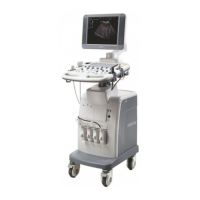5-42 Image Optimization
The region desired is isolated by amniotic fluid adequately.
The region to imaging is not covered by limbs or umbilical cord.
z The best condition is that the fetus keeps still. If there is a fetal movement in
Smart 3D or Static 3D imaging, you need a rescanning when the fetus is still.
Angle of a B tangent plane
The optimum tangent plane to the fetal face 3D/4D imaging is the sagittal section of
the face, or the coronal section. To ensure high image quality, you’d better scan
maximum face area and keep edge continuity.
Image quality in B mode (2D image quality)
Before entering 3D/4D capture, optimize the B mode image to assure:
z High contrast between the desired region and the AF surrounded.
z Clear boundary of the desired region.
z Low noise of the AF area.
Scanning technique (only for Smart3D)
z Stability: body, arm and wrist must move smoothly, otherwise the restructured 3D
image distorts.
z Slowness: move or rotate the probe slowly.
z Evenness: move or rotate the probe at a steady speed or rate.
NOTE: 1. A region with qualified image in B mode may not be optimal for 3D/4D
imaging.
E.g. adequate AF isolation for one sectional plane doesn’t mean the whole
desired region is isolated by AF.
2. More practices are needed for a high success rate of qualified 3D/4D
imaging.
3. Even with good fetal condition, to acquire an approving 3D/4D image may
need more than one scanning.
5.11.2 Overview
Ultrasound data based on three-dimensional imaging methods can be used to image any
structure where a view can’t be achieved by standard 2D-mode to improve understanding
of complex structures.
4D provides continuous, high volume acquisition of 3D images. 4D adds the dimension of
“movement” to a 3D image by providing continuous, real-time displays.
Mode definition
z Smart 3D
The operator manually moves the probe to change its position/angle when
performing the scanning. After the scanning, the system carries out image
rendering automatically, and then displays a frame of 3D image.
z Static 3D
Posit the probe at a fixed place; the probe automatically performs the scanning.
After the scanning is completed, the system carries out image rendering, and
then displays a frame of 3D image.
z 4D
The probe performs the scanning automatically. During the scanning, the system renders
3D images in real time, and all 3D images are displayed in real time.
Term s
z Volume: a three-dimensional content.

